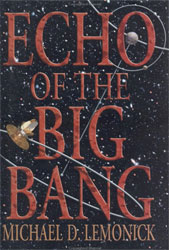
Scientist now accept that the cosmic microwave background (CMB) radiation results from the big bang. This knowledge was slow in developing. In 1920, Shapley and Curtis debated whether the universe is bigger than the Milky Way Galaxy. Yet, pieces of the puzzle kept falling into place, such as the red-shift indicating an expanding universe. However, we knew by then that mass attracts, so why are stars moving away? For resolution, Einstein introduced a cosmological constant (which he later refuted). The accidental discovery of the CMB in 1964 firmly set the stage for the inflationary theory of the universe, yet knowing its existence wasn’t enough. To delve deeper, NASA first sponsored COBE (from 1976 to 1991) then picked WMAP to “drive down the margin of error and nail down the physical characteristics…expansion rate, geometry, matter density, matter to dark matter ratio…”. Thus cosmology follows the typical tale of scientific advancement; the piecing together of little clues to develop an overarching paradigm.
The technical information that relates to the CMB is humongous. This book is not. Lemonick chooses to go the route of simplicity in conveying the scientific details. For the most part, references come with minimal description. For example, the reader is left to wonder about the relative worth of HEMT’s (high electron mobility transistors) to bolometres as the electronic detector of choice. Or for another, we read of omega, the mass/energy density that relates to dark matter and dark energy and to the shape of the universe. There are some standard descriptions, such as of topology and its doughnuts, but that is all. As cosmology combines the skills of many disciplines, this level of detail is necessary for this size book.
Rather than concentrating on the technical aspects, Lemonick emphasises the people. This is sensible as Lemonick is not a cosmological theoretician, he is a broadsheet science writer. Using a mostly chronological ordering, he presents the prerequisite characters of WMAP and many of the COBE mission as well. We read of anxiety in building the satellite, preoccupation leading to gallbladder surgery, and sleepless nights necessary for processing data. By nicely adding emotion to the description of the scientists, Lemonick puts in a real human flavour. This lightens the topic, but if you’re not interested in the side details, such as procurement strategies for high end electronics, this can be a bit off putting.
Further, continual side steps into this trivia or some person’s characteristic traits makes this book hard to classify. At times, it seems quite eloquent, such as the setting described as “…after a mild winter, the brilliance of the campus in full bloom is almost overwhelming”. This same style relates to system testing where the satellite is “…plunged down to extreme cold, vibrated, bombarded with simulate microwave signals, blasted with sound waves from gigantic loudspeakers four feet across”. With these, the reading is simple but the overall sense is of a smooth series of factoids presented one after the other. Once finished, the reader should feel quite prepared for a game of Trivial Pursuit, the Cosmology Edition (if it exists).
If you’re looking for a well written, entertaining science book that is easy to pick up and put down, this is it. There’s enough substance to keep you interested while sitting on the bus commuting into work. However, there’s not enough to over embellish the lore of cosmology, the established traits of the pertinent scientists or typify the build out of scientific satellites. A clearer title or a clarifying sub title would have been helpful.
Well, how much are discoveries worth? A satellite can answer fundamental questions about our existence, but only if we want to pay the piper. The WMAP mission was such a story as with a ceiling cost, it successfully answered specific cosmologic questions. Michael Lemonick in his book Echo of the Big Bang brings to us the story of this mission, the people involved and the challenges of high-end electronics. In combining a sense of history with the warmth of personalities he gives the average person a great introduction into cosmology and high end science.
Review by Mark Mortimer
Read more reviews online, or purchase a copy from Amazon.com.
